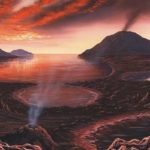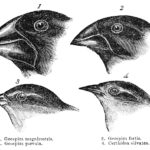You and your friends live in a variety of places, some in apartments, others in homes, trailers, cabins, condos and many other places. All around you both inside and outside there are other life forms. These life forms live in caves, trees, under rocks, in ponds and puddles, in your fish tank, on your countertops, and in many other places. All of us, both friends and creatures, share a larger home. This home is the planet Earth.
How did we all get here? It is the job of a biologist, or someone who studies life, to learn where life came from, how it developed, and to try and determine how life will continue to develop. Biologists today are not completely sure how life began on Earth, but after many years of studying lifeforms, they have come up with guesses. We call these guesses theories.
The most commonly accepted theory is the theory of evolution. This fascinating tale begins with a very big bang, and ends with you reading this article today on our website.
|
About 4.6 billion years ago our Earth looked very different than it does today. Instead of the beautiful blues, greens and whites of today, it would have looked red and orange. The surface of our planet was covered in oceans of hot lava. Instead of breathable oxygen, the atmosphere contained a mix of deadly poisons. |
|
For the first 500 million years, the Earth would remain as a giant lifeless ball of fiery lava. For another 300 million years after that, it would be too hot for liquid water to form. Finally, after 800 million years, an unimaginably long period of time, our home planet cooled enough for liquid water to begin to form. Everywhere rains began to fall, filling the lower portions of the Earth with water, forming lakes, oceans and rivers.
|
Still, there was no life. No fishes to fill these oceans, no plants to cover the rocky surface, no animals to graze the wilderness. Just a barren wet rock, orbiting the Sun. The Earth’s atmosphere now contained a mix of very poisonous gases, including carbon monoxide, carbon dioxide, nitrogen, hydrogen sulfide, methane, and cyanide. Breathing this air would cause death to most lifeforms as we know them.
|
So how did life arrive on Earth? Which came first, the chicken or the egg? This riddle seems silly, but think about it. Without chickens, there could be no chickens to lay eggs. Yet, without eggs, there could be no chickens, because they could not have hatched. So which came first? A complicated question, and not just about chickens, but about all lifeforms. |
|
What forces changed this barren wasteland into the beautiful garden that it is today? Biologists believe that the process that created life is something called evolution. Earth’s ancient oceans while lifeless, were filled with the chemicals needed for life. These chemicals were not alive, but they were there sloshing around. They call these chemicals “primordial soup.” Instead of alphabet letters, this soup was filled with amino acids, proteins, lipids, and other basic components that are commonly found in lifeforms today. |
It is believed that life began on the shores of these ancient oceans in pools of water called tidal pools. These shallow pools would have been full of this “life soup”. Over many millions of years, as the ingredients of life splashed around in these pools, possibly helped by lightning strikes, they formed the first cells.
|
What is a cell? A cell is a basic unit of life. They are tiny packets, or bags, of organelles, or tools, needed for the cell to survive. A cell can eat, move around, and reproduce. These cells took the chemicals of life found in the soup and put them together inside protective sacks. These first cells were very simple and because there was little or no oxygen available, they probably did not need it to survive. |
|
What did these first cells eat? As strange as it may seem, the first cellular lifeforms on Earth probably ate soup. Not Chicken Noodle Soup, but the same soup that they formed in. At that time, there were plenty of proteins, amino acids, and lipids to go around. The first cells were probably all consumers, the ancestors of animals. |
Over millions of years’ time, food supplies began to dwindle. As a result, new types of cells had to form. These cells were called producers. Producers evolved the ability to actually create their own food, using the chemicals around them and the energy from the Sun, or from heat found in the Earth. These producers would be ancestors to the plants.
|
From very simple cells, to multi-cellular human beings, life had a long way to go. A number of very important advances in evolution allowed life to become what it is today. The first important advancement was the development of cells that use oxygen. Remember, the first cells could not use oxygen because there was not enough of it in the air. However, as these first cells carried out the business of living, they released oxygen into the atmosphere. Over a very long period of time, our atmosphere changed from a poisonous and deadly mix of gases to the atmosphere we know and love today.
|
|
As the atmosphere changed, so did life. Cells evolved that could use oxygen to carry out their bodily functions. Because oxygen is a much more efficient gas, this opened the door to larger, faster, and more complex cellular lifeforms. |
The next major evolutionary advance was the development of multi-cellular lifeforms. No longer was life limited to just one cell. Creatures began to arise that were made up of two cells, ten cells, or even thousands or billions of cells. These cells began to specialize in different jobs, some acting as hearts, others as eyes, others as brains, allowing life to become very complex.
|
Survival of the Fittest But wait a minute. Are we saying that life started as a simple soupy mixture of chemicals and then on its own grew to form hippopotamuses, elephants, and all other forms of life? Who decided what animals would look like? Who decided that ears would be on the sides of an animal’s head, eyes in front, and a nose in the very middle? Didn’t someone or something have to direct this process? |
|
In a manner of speaking, yes. Biologists believe that the something that directed evolution is what is known as Natural Selection. This law says that the strongest lifeforms live, while those that are weaker die, and is often referred to as survival of the fittest. In other words, if there are 100 hippopotamuses in a herd, only the strongest will live to reproduce, or to create offspring. |
But how does Natural Selection determine what an animal will look like?
Think about it. Who do you look like? Your mother? Your father? Your uncle Lenny? You look like your ancestors, the people who created you. If only the strongest hippopotamuses survive to create baby hippopotamuses, then the babies are going to resemble the strong hippos. If these hippos have ears on the sides of their heads, then so will the babies.
|
Now let’s suppose that some of the hippos have bigger mouths. As a result, they are able to eat more food. As the bigger mouthed hippos eat all of the food, there is less for the smaller mouthed hippos. What happens? More of the bigger mouthed hippos survive to reproduce, meaning that many of the baby hippos will have big mouths. |
|
Over millions of years, plants and animals have evolved into many different forms. Some with big mouths, some with small mouths, some with sharp teeth, some with no teeth, eyes in the front, eyes on the side, two eyes, eight eyes, and everything in between. All of this evolution guided by the simple law of survival of the fittest. |
Let’s consider another example. Instead of hippopotamuses, this time we will examine birds. Birds have a very big advantage over other lifeforms. They can fly. This ability allows them to move around quickly, as well as the ability to easily escape from predators.
|
How did birds develop the ability to fly? According to what we have learned so far, this ability should have come about as a result of Natural Selection and survival of the fittest. |
|
Let’s suppose that many millions of years ago there were bird-like animals that could not fly. Over time, some of them developed the ability to hop around and possibly even glide short distances. This ability gave them a clear advantage over others in their flock. They could more easily escape enemies, find food, etc. Because more of them survived, their babies inherited the ability to hop and glide. Just like you might inherit the ability to slamdunk a basketball or to do gymnastics. |
Now let’s suppose that in the next generation of birds, a few of them could glide a little further and a little higher. Again, because they can get away from predators more easily, more of them survive to reproduce, meaning that more of the baby birds will inherit the ability to glide further.
Eventually over millions of years, birds became very skilled flyers, from eagles to humming birds.
Evolution continues today. Guided by survival of the fittest, lifeforms are continuing to change and evolve. The plants and animals we know today will be very different in the future. Who knows what creatures will evolve. Who knows how humans will evolve. Even our own offspring may look very different millions of years from now.






